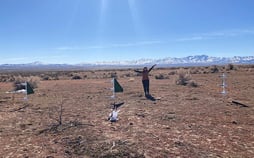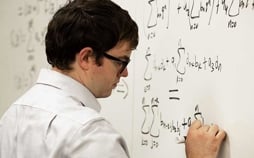Clearing the Air
Abby Mangum’s passion for helping people and communities respond to disasters led her to research earthquakes and tsunamis as a BYU undergrad.
October 2025
 Ammon Shurtz is a BYU computer science PhD student researching artificial intelligence (AI) and language technologies, with a focus on low-resource languages.
Ammon Shurtz is a BYU computer science PhD student researching artificial intelligence (AI) and language technologies, with a focus on low-resource languages.
“In my research, and in the work at the BYU MATRIX Lab, we’ve had the opportunity to collaborate with the Church’s translation department,” he says. “We’ve worked on improving AI translation technologies, which are an integral part of the Church’s translation pipeline.”
These tools help speed up the work of the hundreds of human translators who make General Conference and Church materials available in so many languages. In fact, this year alone, Church materials are being translated into 25 additional languages—including 12 sign languages. In total, the Church translates about 100 million words each year.
Despite this monumental effort, these translations account for less than 2% of the world’s more than 7,000 languages. Shurtz’s goal and focus of his research is to expand that reach by improving AI translation for those underserved languages.
“I served my mission in Cambodia, my ancestral homeland, spending every moment of my time teaching others about the light of Jesus Christ,” Shurtz says. “The members in Cambodia, and members across the world, deserve to learn of Christ in their own native language. That motivates me to work hard every day to solve difficult problems so that they—and millions of others—can have access to these tools and opportunities.”
Shurtz has mentored many undergraduate students at BYU whose research opportunities, including his own, were made possible through donor funding. Together with Dr. Steve Richardson, he co-founded the MATRIX Lab three years ago, tackling projects in sign language translation, speech technologies, and low-resource language processing. Shurtz has seen evidence of divine guidance throughout their work, which shapes both the questions they ask and the solutions they discover.
One such moment came when he attended a computational linguistics conference in Italy. An unexpected insight from a session outside his field sparked the idea for his thesis to improve translation for Southeast Asian languages using phonemic transcriptions. When he and his team discovered no existing transliteration tools for Lao or Cambodian, he and freshman student Christian Richardson built the first IPA transliteration software for both. What began as a small problem became a breakthrough, and the tools are now being made publicly available to researchers worldwide.
Looking at his time at BYU, Shurtz sees revelation intertwined with his research. “My motivation has come from the Spirit’s confirmation that human communication matters deeply to God and His children,” he says. “The solutions I’ve been part of have come not just from technical effort, but also from inspiration in moments of uncertainty. And some of the most impactful results have come as unanticipated blessings—unexpected upsides that can reach far more people than I ever imagined.”
Learn more about how you can help BYU students in the College of Computational, Mathematical, and Physical Sciences here.

Abby Mangum’s passion for helping people and communities respond to disasters led her to research earthquakes and tsunamis as a BYU undergrad.

Mathematics student Jonathan Hales says it was mentored learning that helped him develop a method that researchers can use to analyze equations.

Jahari Williams was raised by his grandmother in Maryland, and when he was in high school, he discovered a love of the French language and culture.